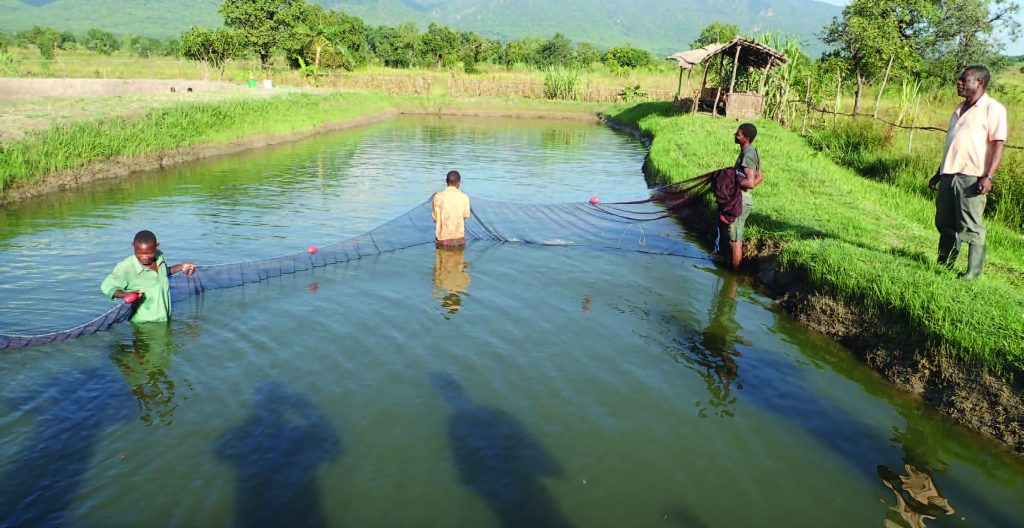Questioning Malawi aquaculture prospects
Policy frameworks capitalising on favourable natural conditions have been laid down to trigger a blue revolution in the country but experts warn that unregulated fish imports keep frustrating local fish production.
The experts have since called upon authorities to revisit their priorities to protect local interests.

Africa Policy Research Network for Fisheries and Aquaculture president Sloans Chimatiro says an analysis shows it is extremely expensive to produce fish in Malawi.
“Malawi has deliberately created a good environment for fish imports as in 2018 alone, fish valued at six million dollar was imported into Malawi, consequently suppressing growth of the local fish industry.
“There is big opportunity to market fish in Malawi but it is hostile to produce,” he says.
Chimatiro says fiscal incentives in Malawi are not good for business growth as investors would rather do fish farming elsewhere and return to Malawi to sell the product. He said this in reference to an influx of foreign branded fish products on the local market.
He says granting of a once-off annual fishing licence permitting fish in the country’s natural water does not help things as it makes fish farming less viable.
“Why should people bother about fish farming when it is easier catching it in the lakes?” observes Chimatiro.
Aquaculture Value Chains for Higher Incomes and Food Security Project (AVCP) team leader Ladislao Di Domenica, admits that many subsistence fish farmers in the country cannot afford floating feed needed for commercial farming.
He maintains that fish farming should change from being a hobby to entrepreneurship.
“We need to support small-scale fish farmers in a coordinated approach beyond the current scope with government showing more commitment.
“As GIZ / AVCP, we are already supporting fish farmers to take fish farming as a business through various short trainings,” Di Domenica says.
Financing fish farming is a big challenge as lending institutions are skeptical of aquaculture.
Di Domenica suggests a negotiated flexible loan package for low-risk fish farmers.
The Department of Fisheries concurs that fish farming is a profitable venture.
Its analysis indicates that raising chambo in a one-hectare pond and adhering to deep pond production technologies and applying all management aspects could produce up to six tonnes of fish which if sold at K2 500 per kilogramme, could rake in a profit of K 8 million.
However, the six tonnes of fish would require K7.5 million worth of feed, which most farmers can hardly afford.
An aquaculture expert, Hastings Zidana, who heads the National Aquaculture Centre, observes that it is crucial that the banking sector is informed on the economic viability of fish farming for farmers to have access to financing.
“We need to let the banking sector know the viability of fish farming so we clear the misconception that it is a credit risk. We agree to design a special pilot loan package for fish farmers to unlock the potential,” he explains.
Zidana agrees that subsistent fish farming is not profitable as a commercial venture.
Study findings on opportunities and challenges of small-scale fish farming in Malawi by Mwapata Institute, indicate that most fish farmers realise a median profit value of K25 000 based on a less than 200 square metre fish pond but the profits could increase with increased production sizes and level of inputs, especially quality feed.
The Mwapata Aquaculture Survey reveals fish production remains low compared to fish consumption in the country.
Maldeco Fisheries, the single large-scale producer of aquaculture-grown tilapia in Malawi admits facing production and marketing challenges aggravated by fish imports.
Maldeco Aquaculture operation team leader Penjani Nkhata concurs with Chimatiro, saying his company incurs huge expenses on feed imports and other incidentals making the price of their Malawi chambo exorbitant and uncompetitive.
“Consumers opt for other tilapia imports than locally produced chambo because of the former’s cheaper prices regardless of poor flavour and taste,” he laments.
Aquaculture experts attribute cheaper prices of imported fish to low cost of feed and electricity in neighbouring countries.
Director of Fisheries Friday Njaya says government is committed to addressing challenges in the aquaculture sector for a better growth beyond 2063.
The 2022 Malawi Government Annual Economic Report shows that in 2021, Malawi generated K187.3 billion from the sale of 173 480 metric tonnes (MT) of fish, an increase of 1.5 percent from the previous year.
It is projected that fish production will increase to 178 684 MT and 182 258 MT in 2022 and 2023, respectively and this will translate to increased projected accrued monetary value of K194.8 billion, and K200.5 billion, respectively.





